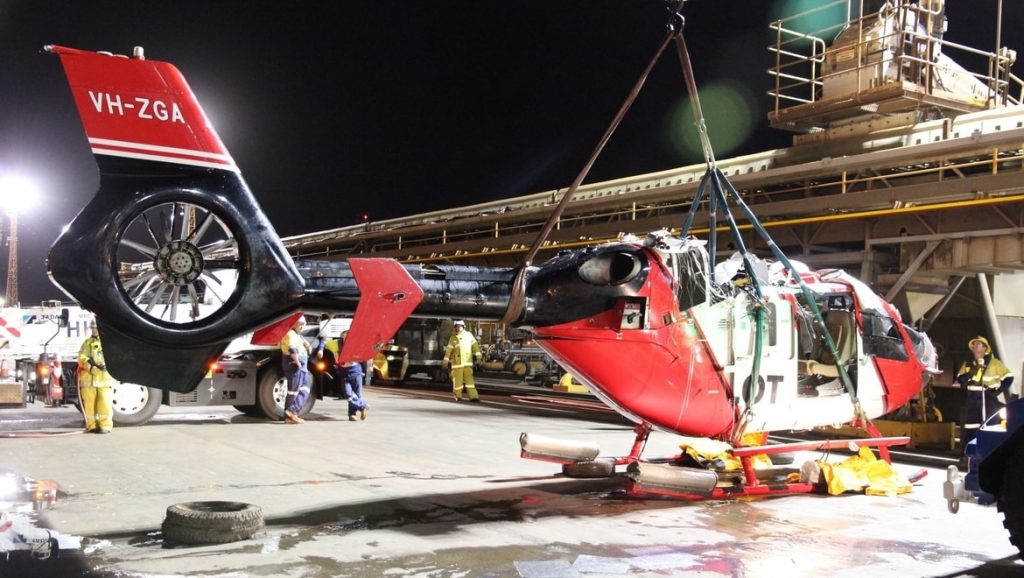
A recently recruited pilot who died when his EC135 crashed into the sea hadn’t undertaken underwater escape training in seven years prior to the accident.
The finding forms part of a four-year ATSB investigation into the incident off WA’s north coast in 2018 that saw an instructor pilot survive after deploying a life raft located on the aircraft’s landing skid.
However, the other pilot didn’t escape and was subsequently located by police divers in the cockpit three days later, with the Eurocopter resting on its right side on the seabed in 20 m of water.
“This lack of recency reduced their preparedness for escape once the helicopter hit the water and rolled over,” said ATSB chief commissioner Angus Mitchell.
“Helicopter underwater escape training (HUET) provides familiarity with a crash environment and confidence in an emergency, for this type of accident.
“Interviews with survivors from helicopter accidents requiring underwater escape frequently mention they considered that HUET had been very important in their survival.”
The final ATSB report detailed how two pilots – an instructor and a pilot under supervision – were operating an EC135 twin-engine helicopter under night visual flight rules (night VFR) to collect a marine pilot from an outbound bulk carrier on the night of 14 March 2018.
During a second approach to land on the ship, the helicopter descended rapidly and impacted the water. The instructor pilot was able to escape the cabin as it flooded, while the pilot under supervision was not able to escape, and did not survive.
ATSB Chief Commissioner Angus Mitchell encouraged all helicopter pilots and operators to review the investigation’s final report, and consider the findings in the context of their own operations.
“This was a complex investigation, which has already resulted in several safety actions being taken by the operator and the regulator,” Mr Mitchell said.
While the meteorological conditions during the accident flight met the standards for a night VFR operation, the investigation found that low celestial lighting, and the lack of artificial lighting 37 km offshore, meant the helicopter was being operated in a degraded visual (cueing) environment.
“Helicopter pilots operating in a degraded visual environment are exposed to a higher workload and a heightened risk of spatial disorientation,” Mr Mitchell said.
The operator’s training and assessing procedures for marine pilot transfer operations did not provide assurance that pilot under supervision experience, helicopter instrumentation, and instructor capability were suitable for line training at night in these conditions, the investigation found.
“The accident flight was a line training flight, with the pilot under supervision in the right seat, and the instructor in the left seat,” Mr Mitchell explained.
“However, the helicopter’s instruments were set up for a single pilot in the right seat. This limited the instructor’s ability to monitor the flight path and take over control if necessary, particularly in the degraded visual environment.
“For any operation that relies on the instrument flying skills of a second pilot, consideration should be given to the adequacy of flight instrumentation for that pilot.”
Mr Mitchell noted the Civil Aviation Safety Authority (CASA) has, since the incident, updated two of its regulations (CASR 91 and CASR 138), stating cockpits designed for single pilot operations need to be carefully assessed for instrument readability before being used for training, checking or testing operations.
Additionally, the ATSB’s investigation found the pilot under supervision probably experienced a level of fatigue known to adversely influence performance. While there was insufficient evidence to establish fatigue for the instructor pilot, it is likely they were experiencing a level of fatigue in previous days.
“The investigation found technical and methodological flaws in the operator’s fatigue risk management system, and that the operator did not conduct a formal risk assessment of its roster prior to commencing marine pilot transfer operations at Port Hedland,” Mr Mitchell said.
“Flight crew fatigue is an insidious problem that is difficult to predict for each individual on an ongoing basis and can have subtle effects that undermine performance of critical tasks.
“Management of fatigue risk is a shared responsibility between operators and pilots and relies on sound principles, effective systems, and accurate recording.”
The investigation also found the pilot under supervision had not undergone helicopter underwater escape training (HUET) since 2011, seven years prior to the accident.
“This lack of recency reduced their preparedness for escape once the helicopter hit the water and rolled over,” Mr Mitchell said.
“HUET provides familiarity with a crash environment and confidence in an emergency, for this type of accident.
“Interviews with survivors from helicopter accidents requiring underwater escape frequently mention they considered that HUET had been very important in their survival.”
















Craig
says:The training not undertaken by the pilot who died, would’ve saved his life.
Very hard to comprehend that someone in a possible risk scenario job didn’t keep training current.
It’s imperative that all job training be literally up-to-the-minute.
It’s there for a reason.